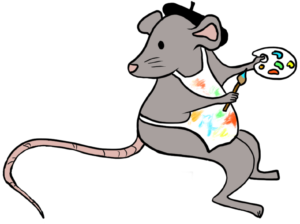Part 1: The Mission
1.3 Audience
Learning Objectives
- To describe a target audience based on characteristics that will impact communications intended for them.
- To hypothesize how those characteristics might impact your communication program.
- To provide examples of how you can go about conducting audience analysis.
- To define intersectionality in communication practices.
- To explore how a consideration of intersectional identities can be incorporated into communication campaigns.

Before you begin any kind of communications planning, think of your audience. Who are you wanting to reach? Why are they your target group? The better you know your audience the better your chances of successfully developing and delivering your message (or even knowing what your message should be). If your audience is small and/or very well defined (i.e., a particular governmental agency) then this task may be straightforward. However, chances are that you will be dealing with a larger and more amorphous collective often known as ‘the public’. If there is one key take home message for this section let it be this: there is no such thing as “the public”. As scientists we often think of the ‘the public’ as a homogenous group when really, they are a mosaic of individuals with different knowledge bases, different lived experiences, different values, different goals, etc. For this reason, it is important to spend some time and effort on audience analysis (also known as “understanding your audience”). Below are some characteristics and considerations that you can use to better understand your audience.
- Group size: Collaborative forms of communication are usually only feasible for smaller groups. The group size also impacts the medium you select. For example, a small group size could warrant a presentation or meeting, while a larger group might require communications disseminated through social and news media.
- Personal characteristics (age, gender, culture, religion): All of these will impact how people view the world, what is important to them, how they receive, process, and react to information, etc. However, it is important to remember that ‘rough categories’ are not the only determinants of how someone receives a message. Aspects of someone’s lived experience will also characterize how they engage with your messaging; however, these qualities are much harder to describe.
- Education level: This will help you to tailor the language and level of detail. Generally, aim for language free of scientific jargon to reach the largest group of individuals. You can test the grade level of the language you are using online here.
- Language: Are there multiple languages spoken by the audience or is their preferred language different than your own? You may need to bring in translators to adequately convey your messaging in the desired language.
- Experience with the issue in question: How much does your audience already know and what will you have to educate them about?
- Attitude towards the issue: Is there likely to be apathy, outrage, or hot button words and concepts?
- Experience with and attitude towards you and your organization: Do people know you, trust you, and find you credible?
- Individuals or organization that they trust: Could you recruit those people to be your spokesperson and/or participate in the communication process?
- Expectations: What will your audience expect from you? Can you deliver on those expectations?
- Information sources: Where do people tend to get their information from? It is ideal if you can use their preferred medium (i.e., social media, traditional media, podcasting, etc.).
- Intersection of issue and audience: Is there some feature of the audience that impacts the effect of the issue on them as compared to other groups? For example, people living in under-served areas may have fewer resources to cope with or mitigate risk compared to those living in more affluent areas.
Other characteristics to consider: Turnover within the community in question, occupation, geography, presence of organized groups (e.g., activists)
Discussion
Here are some other points to keep in mind with regard to ‘the public’ and how they receive and process information:
- Recall of science facts > knowledge of scientific methods
- Most people’s formal science education ends in high school
- Scientific numeracy is more difficult than scientific literacy
- May have multiple, idiosyncratic explanations for a phenomenon
- May not focus on most relevant aspects of an issue
- Reliance on metaphor and analogy
- People weigh more heavily information that fits with their beliefs or information they’ve seen before
- Initial emotional reaction can shape long-term attitude and receptivity to future information
- Reliance on narrative and framing as replacement for not understanding numbers
- Cognitive dissonance (discomfort from holding two conflicting thoughts) often leads to rejections of new information that threatens things people hold dear
- Prone to cognitive bias
- People are busy and bombarded with information, make sure your messaging grabs their attention and does not waste their time


Audience analysis
Audience analysis is any communication research conducted on a target audience to gather information about their media habits, attitudes, interests, behaviors, preferences, demographics etc. But how do you obtain this information? You could, for example, collect data directly from segments of your target audience using interviews, surveys, and focus groups. Alternatively, you could use indirect sources such as internet searches, social media, and census or other administrative data. There are also some ‘outside the box’ information sources, such as political groups, which may be willing to share data on their constituency, particularly if they feel that your message will bring a benefit to the community. Often, you will have to use multiple data sources to both develop and verify your audience profile.
Example
An audience analysis for communication is much like approaching marketing of a brand or product. If you’ve created a new running shoe for long-distance runners, you want to know that your product and the promotional materials associated with it engage your target audience (long-distance runners). The first step in that process is having an understanding of the products these individuals already use, the places they run, and the organizations that sponsor them.
Similarly, when communicating about risk, you must identify and understand your audience, their values, and the modes of communication they engage with. For example, if you are communicating to a community-run organization, visit their website and pay particular attention to their goals and initiatives, visit their social media pages to see what information they share, meet with organization members where possible to ask about their programs and interests. If you have been invited to speak by the organization, you can request information on your audience directly from the spokesperson.
Audience testing
Now that you have gathered information on your target audience, it’s important to test your communications strategy on a subset of this group (this is an example of ‘pre-testing’ from section 1.2). This is because implementing any communication strategy is expensive, so piloting aspects of this strategy prior to full dissemination can help to minimize costs and iron out any bugs in your tactics. Be sure to collect feedback from the pilot group and incorporate this feedback into the final communications materials, where possible.
Supplementary Material
The Secondary Audience
by Claire Styffe (SPPH 552 2020W1)
Since beginning taking this class, I’ve recently gone and rewatched the movie Thank You For Smoking.1 It’s the satirical story of Nick Naylor, a lobbyist for cigarette companies and it’s full of interesting themes surrounding public health and communication. On this latest watching however, a specific point stuck out with me, particularly in the context of our class discussions surrounding audience. I’ve attached a clip from the movie, and in it Nick is telling his son Joey what he does for a living, and how he argues. To do this, he presents a mock argument with his son, a fight over the best ice cream flavour. After Nick gives his closing statement, Joey is confused.
“But you still didn’t convince me,” he says.
“But I’m not after you,” Nick explains. He points into the crowd of milling people, all of them enjoying their night at the amusement park. “I’m after them.”
This quick clip illustrates what we studied in class; the importance of knowing who your audience is, and tailoring everything accordingly, from what you’re saying, to the way you say it. It also draws my attention to the fact that your message may have key secondary audiences, and that this should also be factored into your communication. An area where these principles are particularly important is in addressing vaccine denialism.
There exists a spectrum of vaccine hesitancy.2 There are vaccine sceptics, who are uncertain regarding vaccination, but who take a scientific approach to the matter and are willing to follow the facts should they be presented appropriately. Moving further along are the vaccine refusers, who chose not to vaccinate, are confident in this decision, but who are still willing to listen to alternative perspectives. Furthest along are the vaccine deniers, who have an extremely negative perception of vaccination and are not at all open to changing their beliefs, no matter the scientific evidence which may be presented. Most of the time, it is the vaccine deniers who tend to be the most vocal of the vaccine hesitant population, and the ones who science communicators may have to interact with on a very public stage.
The WHO has published an in depth document called How to respond to vocal vaccine deniers in public.2 Rule #1 is “The general public is your target audience, not the vocal vaccine denier”. Ignoring for a moment the issues of nomenclature (there is no general public!) they bring up a key point; that the person you are arguing with directly is unwilling to consider alternate positions and the evidence supporting them, and that your efforts should be geared toward the larger portion of the population who would. This is echoed in Leask’s research regarding changing vaccine uptake called, Target the Fence Sitters.3 In it she presents evidence that a small and very vocal section of the vaccine hesitant are unlikely to ever change their position, but that the quiet majority of them are more concerned than they are obstinate. When presenting your message it’s key to think about how responding to one group may be actually about communicating with another. In the crude words of Nick Naylor, who are you after? Is it the person you’re talking to? Or the ones who are listening?
Works Cited
- Thank you for smoking. United States of America: Searchlight Pictures; 2006.
- World Health Organization. How to respond to vocal vaccine deniers in public. 2016.
- Leask J. Target the fence-sitters. Nature. 2011;473(7348):443–5.
Intersectionality
Another way to help you think about audience is the concept of intersectionality. Intersectionality is the foundation to understanding how multiple identities and experiences exist and interact within an individual or group of people. The term was first coined by Kimberlé Crenshaw over 30 years ago to describe how social identities intersect. We can visualize intersectionality as a unique series of Venn diagrams, with circles representing distinct identities that overlap with one another (as in this illustration by Sylvia Duckworth). These identities may be political or social, religious, of gender identity, race, experience, physical, or any form of disability, and they can interact in such a way as to illuminate discrimination, disadvantages, privileges, and/or prejudices within a societal framework.
Intersectional communication recognizes that the person as a whole is more than the sum of their identities. How these identities interact and intersect create a unique experience. Including and welcoming intersectional identities in your communication practice both makes your communication more inclusive (Canfield et al. 2020) and more effectively targets a message to a specific audience. By carefully considering audience identities, communicators can create materials that reflect the concerns and needs of the audience. Further, the more engaged and welcome the audience may feel, the more likely they are to provide honest, effective feedback that can be used to further improve messaging.
Beyond considering intersectionality, what are some steps you can take to incorporate diverse identities into your communications?
Because intersectional work is intertwined with efforts to address and improve equity, inclusivity, and diversity, intersectional communications will benefit from applying inclusive, equitable practices. Where possible, collaborate with those with experience and expertise in equity, diversity, and inclusion to help incorporate diverse perspectives into the communications process and identify biases that could be a barrier for your audience.
Another way to incorporate intersectionality into your practice is to center the voices of those most affected by the issues that you are communicating about. For example, if you are discussing the risks of hurricanes in the southern United States, then communications would be strengthened by sharing the experiences of residents of the areas most affected. By centering the voices of those affected by an issue, the message better reflects audience concerns, which in turn enhances relevance, engagement, and action.
Incorporating intersectionality is ultimately about understanding your audience! It requires that you identify your target audience, as well as use commonly inclusive practices such as polling (social media and in-person), interviews, and surveys to understand who they are and what they care about.
Example
The “Wash With Care” program is a provincial program aimed at raising awareness about pesticide safety among the farming community in British Columbia. Specifically, the program created educational tools to share with community members about how to properly wash clothing to lower health risks for farm workers and their families associated with pesticides and pesticide contamination.
The Wash With Care program is an excellent example of how intersectionality shapes communications materials.
The program’s target audience was farm workers and their families. Within this audience, the program identified that many farm workers spoke Punjabi, but that there were few educational materials provided in Punjabi. Because women within families were also identified as the family members primarily involved in laundering clothing, the program specifically aimed to create messaging in Punjabi for women. Through qualitative interviews, community members suggested that the program use Bollywood-style messaging through TV and video. This led to the creation of two Bollywood-style Public Service Announcements (one brief, one longer) including local celebrities that introduced safe handling practices for pesticide-contaminated clothing. The program also created written materials in Punjabi to be disseminated to the community.
In this way the program created materials that were specifically tailored to the interests and suggestions of Punjabi-speaking farm families. For more information about the process of engaging with community members and creating these materials, see this link.
Takeaways
Key Takeaways
- The audience for your communications plan will determine all aspects of how you communicate, from language, to tone, to the medium used.
- Gathering information on your audience can be challenging, but an audience analysis can be highly informative when determining how best to communicate.
- Once you have developed some communications materials, testing these materials on a subset of your audience and receiving feedback can help in further refining your message.
- People hold multiple identities spanning gender, race, physical ability, socioeconomic status, education, political views, etc. These identities influence how we all receive and engage with communications materials.
- Considering intersectionality is another way to think about your audience! It both allows you to be more inclusive in your messaging, as well as more specifically message to a target audience.
Media Attributions
- Fig 1.3.1 Multiethnic Diverse People in a Circle Holding Hands © Helge V. Keitel is licensed under a CC BY (Attribution) license

